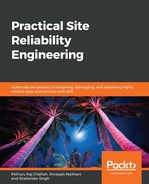The cloud idea has disrupted, innovated, and transformed the IT world. Yet, the various cloud infrastructures, resources, and applications ought to be minutely monitored and measured through automated tools. The aspect of automation is gathering momentum in the cloud era. Every activity is getting automated through pioneering algorithms and technologically powerful tools. A slew of flexibilities in the form of customization, configuration, and composition are being enacted through cloud automation tools. A bevy of manual and semi-automated tasks are being fully automated through a series of advancements in the IT space. In this section, we are going to discuss the infrastructure monitoring toward infrastructure optimization and automation. There are processes, platforms, procedures, and products to enable cloud monitoring.
Enterprise-scale and mission-critical applications are being cloud-enabled to be deployed in various cloud environments (private, public, community, and hybrid). Furthermore, applications are being meticulously developed and deployed directly on cloud platforms using microservices architecture (MSA). Thus, besides cloud infrastructures, there are cloud-based IT platforms and middleware, business applications, and database management systems. The total IT is accordingly modernized to be cloud-ready. It is very important to precisely and perfectly monitor and measure every asset and aspect of cloud environments. There is a growing array of approaches for simplifying and speeding up infrastructure monitoring. The operational and logging data of various infrastructural modules and applications throw a lot of insights about their performance, health condition, throughput, scalability, and security. In the ensuing sections, we are going to write about the various technological disciplines that are enabling the monitoring aspect, which is occupying a crucial spot in infrastructure automation.
Embracing the mesmerizing cloud idea is a strategically sound decision for any corporate. A number of business, technical, and user advantages are being easily derived through this cloud enablement process. The cloud conundrum brings the much-needed flexibility in using available capacity of servers, storages, and network solutions. Cloud resources are being made available on demand, and this unique property ultimately results in the optimal utilization of IT resources.
Organizations need to have the capability for precisely monitoring the usage of the participating cloud resources. If there is any deviation, then the monitoring feature triggers an alert to the concerned to ponder about the next course of action. The monitoring capability includes viable tools for monitoring CPU usage per computing resource, the varying ratios between systems activity and user activity, and the CPU usage from specific job tasks. Also, organizations have to have the intrinsic capability for predictive analytics that allows them to capture trending data on memory utilization and filesystem growth. These details help the operational team to proactively plan the needed changes to computing/storage/network resources before they encounter service availability issues. Timely action is essential for ensuring business continuity.
Not only infrastructures but also applications' performance levels have to be closely monitored in order to embark on fine-tuning application code, as well as the infrastructure architectural considerations. Typically, organizations find it easier to monitor the performance of applications that are hosted at a single server, as opposed to the performance of composite applications that are leveraging several server resources. This becomes more tedious and tough when the underlying computer resources are spread across multiple and are distributed. The major worry here is that the team loses its visibility and controllability of third-party data center resources. Enterprises, for different valid reasons, prefer multi-cloud strategy for hosting their applications and data. There are several IT infrastructure management tools, practices, and principles. These traditional toolsets become obsolete for the cloud era. There are a number of distinct characteristics being associated with software-defined cloud environments. It is expected that any cloud application has to innately fulfil the non-functional requirements (NFRs) such as scalability, availability, performance, flexibility, and reliability.
Research reports say that organizations across the globe enjoy significant cost savings and increased flexibility of management by modernizing and moving their applications into cloud environments. There are options galore for choosing various cloud service and deployment models. There are public, private, and hybrid cloud environments. Enterprises increasingly lean toward the proven multi-cloud strategy. Whatever it is, the management and operational complexities of cloud environments are growing steadily. Cloud monitoring and measurement become a difficult affair. The toolsets that are overwhelmingly used for traditional IT infrastructure are found to be insufficient for the modern IT infrastructure. The automated maneuverability of cloud resources and applications through policy awareness is being insisted upon, and hence the IT service management tools have to be equally empowered to tackle the freshly incorporated IT requirements with ease.
